Related Research Articles

A go-fast boat is a small, fast power boat designed with a long narrow platform and a planing hull.
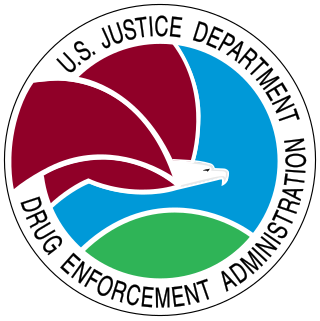
The Drug Enforcement Administration is a United States federal law enforcement agency under the U.S. Department of Justice tasked with combating illicit drug trafficking and distribution within the U.S. It is the lead agency for domestic enforcement of the Controlled Substances Act, sharing concurrent jurisdiction with the Federal Bureau of Investigation, the U.S. Immigration and Customs Enforcement, and U.S. Customs and Border Protection. However, the DEA has sole responsibility for coordinating and pursuing U.S. drug investigations both domestically and internationally.

The Federal Bureau of Narcotics (FBN) was an agency of the United States Department of the Treasury, established in the Department of the Treasury by an act of June 14, 1930, consolidating the functions of the Federal Narcotics Control Board and the Narcotic Division. These older bureaus were established to assume enforcement responsibilities assigned to the Harrison Narcotics Tax Act of 1914 and the Jones–Miller Narcotic Drugs Import and Export Act of 1922.

United States Coast Guard Air Station Clearwater is the United States Coast Guard's largest air station. It is located at the St. Petersburg-Clearwater International Airport in Clearwater, Florida and is home to nearly 700 USCG aviation and support personnel. As of March 2021, there are ten MH-60T Jayhawk helicopters and four HC-130H Hercules aircraft assigned to CGAS Clearwater. Also on static display is USCG 1023, a restored Grumman HU-16 Albatross.

The Campaign Against Marijuana Planting (CAMP) is a multi-agency law enforcement task force managed by the California Department of Justice and composed of local, state and federal agencies organized expressly to eradicate illegal cannabis cultivation and trafficking in California. Since its establishment in 1983, more than 110 agencies having participated, making CAMP one of the largest law enforcement task force in the United States.

The Organized Crime Drug Enforcement Task Force (OCDETF) is a federal drug enforcement program in the United States, overseen by the Attorney General and the Department of Justice. The principal mission of the OCDETF program is to identify, disrupt, and dismantle the major drug trafficking operations and tackle related crimes, such as money laundering, tax and weapon violations, and violent crime, and prosecute those primarily responsible for the nation's drug supply.

Law Enforcement Detachments or LEDETs are specialized, deployable maritime law enforcement teams of the United States Coast Guard. First established in 1982, their primary mission is to deploy aboard U.S. and allied naval vessels to conduct and support maritime law enforcement, interdiction, or security operations. LEDETs are the operational elements of the Coast Guard’s two Tactical Law Enforcement Teams (TACLETs) which were part of the Coast Guard’s Deployable Operations Group (DOG) from 2007 to 2013. As of April 2010 there are seventeen LEDETs.
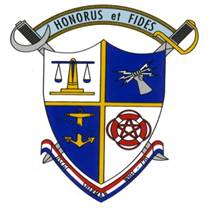
SLNS Gajabahu (P626) is an Advanced Offshore Patrol Vessel of the Sri Lanka Navy. The ship is the second ship named after King Gajabahu I, the warrior king of the medieval Sri Lankan Kingdom of Anuradhapura.
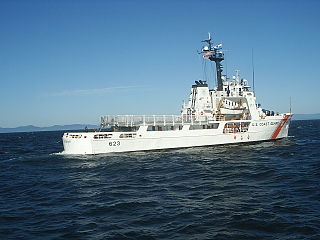
USCGC Steadfast (WMEC-623) is a United States Coast Guard medium endurance cutter and has served the United States for over 50 years. Commissioned in 1968, Steadfast was home ported in St. Petersburg, Florida for her first 24 years of service. In 1992, she was decommissioned for Major Maintenance Availability (MMA) to extend her service another 25 years. Following MMA in February 1994, Steadfast was re-commissioned and home ported in Astoria, Oregon.
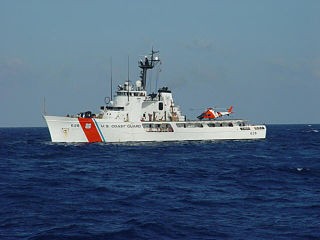
USCGC Venturous (WMEC-625) is a United States Coast Guard medium endurance cutter. The vessel was constructed by the American Shipbuilding Company in Lorain, Ohio in 1967 and commissioned in 1968. The ship has served on both the west and eastern coasts of the United States. The vessel is used for search and rescue, fishery law enforcement, border enforcement and smuggling interdiction along the coasts and in the Caribbean Sea.

USCGC Durable (WMEC-628) was a United States Coast Guard medium endurance cutter. The Durable was the first cutter in Coast Guard history to hold this name. Like all ships in the Reliance-Class of 210-foot (64 m) medium endurance cutters, Durable was named for an aspirational trait meaning to be capable of withstanding wear or decay.

USCGC Dependable (WMEC–626) is a United States Coast Guard medium endurance cutter. Her keel was laid down by American Ship Building Company, Lorain, Ohio July 17, 1967 and she was launched March 16, 1968. Dependable was commissioned November 22, 1968 and her current homeport is Virginia Beach, Virginia. On February 24, 1995, she was decommissioned for Major Maintenance Availability (MMA), an 18-month, 21.7 million dollar project to overhaul and upgrade selected systems and equipment. The Coast Guard anticipates another fifteen years of service due to these renovations. She was re-commissioned United States Coast Guard Yard in Baltimore, Maryland on August 15, 1997.

Visit, board, search, and seizure (VBSS) is the term used by United States military and law enforcement agencies for maritime boarding actions and tactics. VBSS teams are designed to capture enemy vessels, combat terrorism, piracy, and smuggling, and to conduct customs, safety and other inspections.

The Helicopter Interdiction Tactical Squadron (HITRON) is an armed United States Coast Guard helicopter squadron specializing in Airborne Use of Force (AUF) and drug-interdiction missions. It is based at Cecil Field in Jacksonville, Florida.

The illegal drug trade in Latin America concerns primarily the production and sale of cocaine and cannabis, including the export of these banned substances to the United States and Europe. The coca cultivation is concentrated in the Andes of South America, particularly in Colombia, Peru and Bolivia; this is the world's only source region for coca.
Operation Caribbe is the Canadian Armed Forces contribution to the elimination of illegal trafficking in the Caribbean Sea and the eastern Pacific Ocean by organized crime. The operation began in 2006 and its mandate has been altered twice since then. It operates as part of Operation Martillo.

Aviation Drug-Trafficking Control Act of 1984 is a United States Federal law amending the Federal Aviation Act of 1958. The statutory law authorized criminal penalties for the unlawful aerial transportation of controlled substances. The Act of Congress mandated the revocation of aircraft registrations and airman certificates by the Federal Aviation Administration whereas an aircraft aviator knowingly engages in the transit of illicitly used drugs. The Act established authority and a statute of limitations for the reissuance of airman certificates by the United States Secretary of Transportation.

Operation Kruz Control was a twelve-month, multi-agency investigation of a drug trafficking organization in southern Arizona, between December 2012 and December 2013.
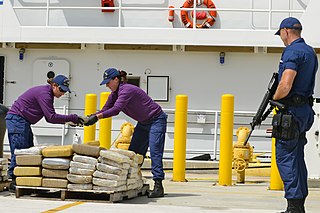
Operation Martillo is an ongoing multi-national anti-drug operation that began on 15 January 2012, and "aims to combat international drug trafficking, and promote peace, stability in Central and South America", according to the U.S. Southern Command, as one of the public institutions involved in it. It is a defense project led by the United States Southern Command with help of multi-national forces from Latin American and European countries. News coverage of their activities and results began in 2012, but mainly from defense-focused media.
The cannabis policy of the Reagan administration involved affirmation of the War on Drugs, government funded anti-cannabis media campaigns, expanded funding for law enforcement, involvement of the U.S. military in interdiction and eradication, reduction in emphasis in drug treatment, and creation of new Federal powers to test employees and seize cannabis-related assets.
References
- ↑ "Name Of Pot-Laden Ship Sounded Familiar To Coast Guard". Miami News. December 11, 1977.
- ↑ "Marijuana Seizure Was Largest Haul On Record". Lakeland Ledger. Florida. April 20, 1978.
- ↑ "The Battle Against Drugs Takes to the Seas: High Seas Drama When the Night Train was Seized by the Coast Guard". U.S. News & World Report. Vol. LXXXIV. March 27, 1978. pp. 69–71.
- ↑ "DEA and Coast Guard Could Almost Track Drug Ship By The Smell". St. Petersburg Times. July 11, 1978.
- ↑ "Operation Stopgap". The Spokesman Review. September 16, 1978.
- ↑ "Operation Stopgap Nails The Legendary Night Train". St. Petersburg Times. July 11, 1978.
- ↑ "Satellites Aiding In Pot Seizures". Sarasota Herald-Tribune. July 11, 1978.